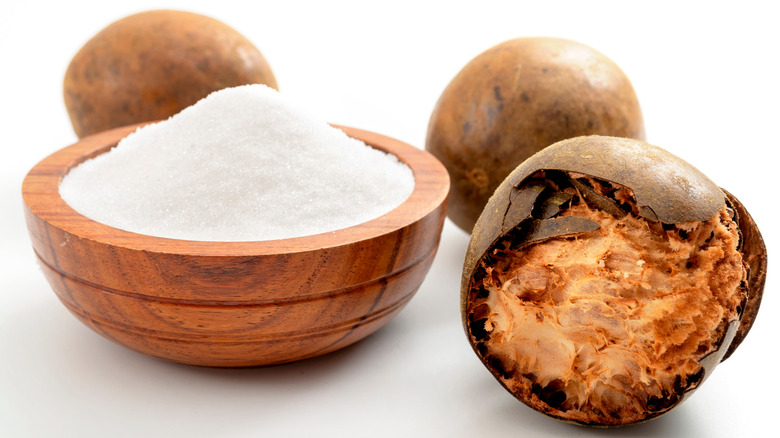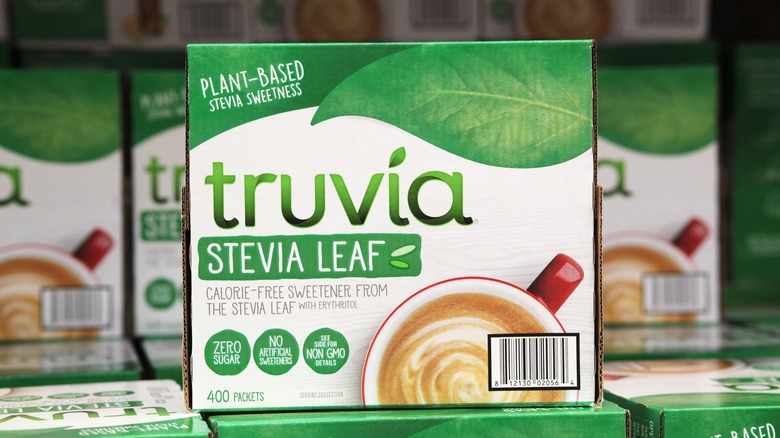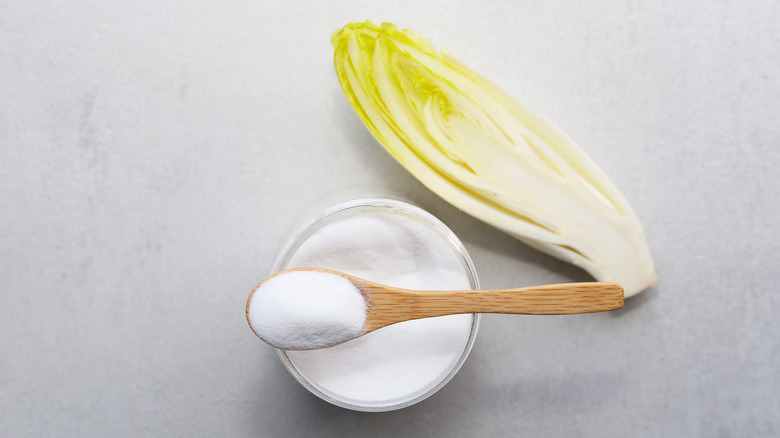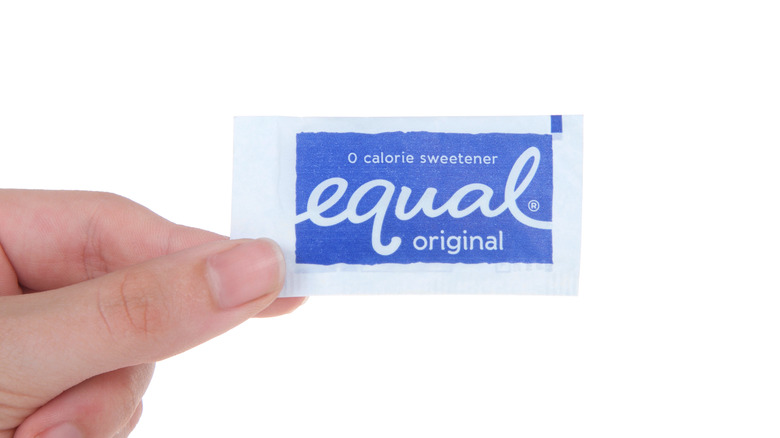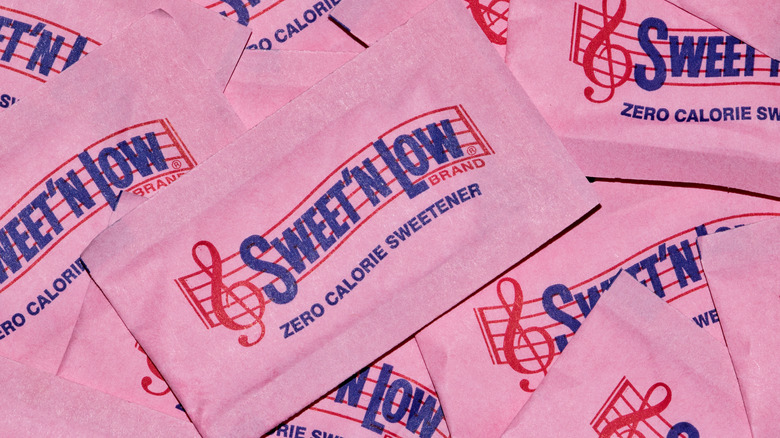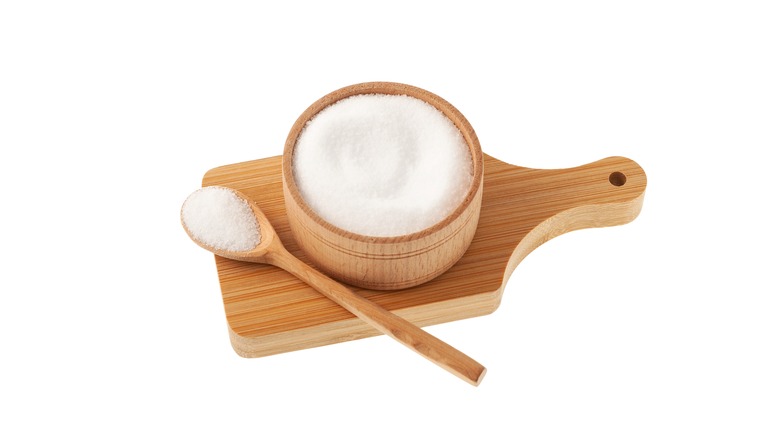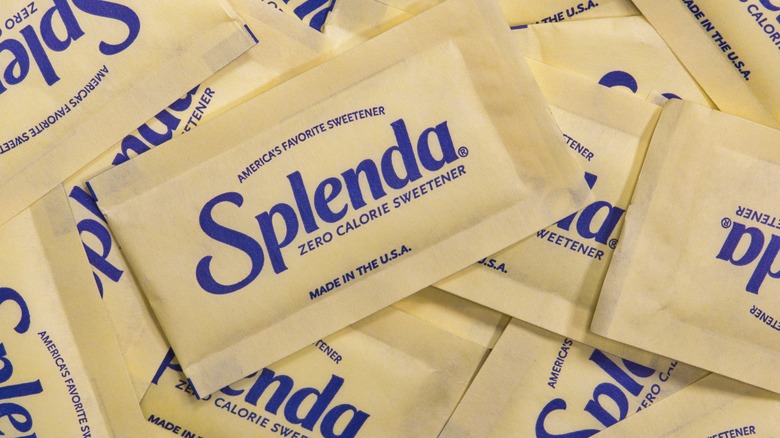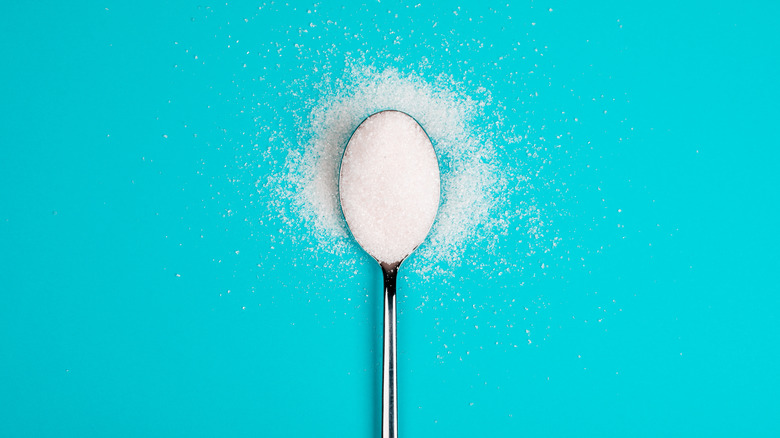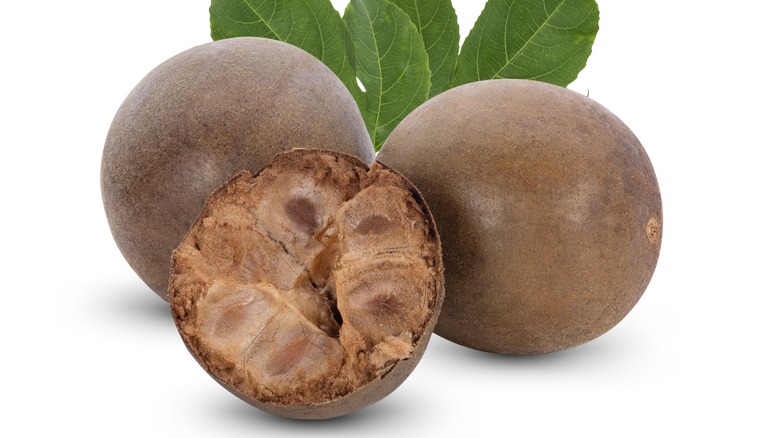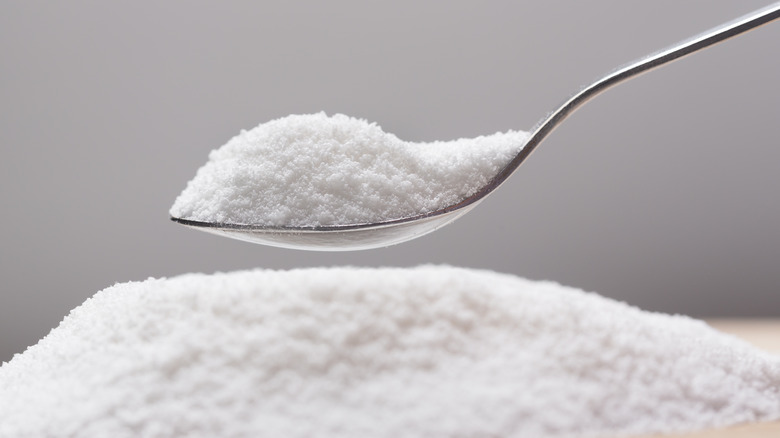12 Zero-Calorie Sweeteners And Their Ingredients, Explained
Ah, the irresistible sweetness of sugar. Humans have had a sweet tooth for at least 2,500 years, which is how long ago the first chemically refined sugar appeared in India. Since then, it's become a staple in the American household, but not without some consequences. With the rise of diabetes and obesity in the United States, more and more people are looking for healthier alternatives to sugar; from the best sugar substitutes for your coffee to zero-calorie sweeteners that can keep your muffins tasting just the way your grandma made them, researchers have come up with a wide variety of zero-calorie options that satisfy the palate and don't pack on the pounds.
Since the first artificial sweetener was discovered in 1879, scientists have discovered and synthesized dozens of chemicals that imitate the sweet taste of sugar. But some sweeteners have a checkered past. Cyclamate, which was approved by the FDA for human consumption in 1951, was later discovered to cause tumors in rats and was pulled from shelves in 1970. More recently, studies have been conducted on the effects of artificial sweeteners, which is why the WHO is reinforcing its warning about sugar substitutes.
But not all zero-calorie sweeteners are synthesized in a lab. Monk fruit and stevia, for example, contain naturally occurring sweet compounds that mimic the sweet taste of sugar and are often marketed as healthy alternatives to chemically synthesized sweeteners.
With the diverse array of zero-calorie sweeteners available on the market, we've done a deep dive into twelve popular brands and the ingredients they contain so that you can stay informed about the products you love.
Truvia
Truvia is the second most popular sugar substitute in the United States, so it ought to be a good one. Part of the reason for its popularity is that Truvia contains only ingredients derived from natural sources. The main ingredients in Truvia are rebaudioside A (listed as Rebiana in the ingredients), which is a compound extracted from the stevia plant. Unlike steviol compounds, the other main sweetener found in stevia, rebaudioside A is not linked to any health benefits.
The other main ingredient in Truvia is erythritol, a type of sugar alcohol that occurs naturally in the process of fermenting things like beer, wine, and cheese. It's produced commercially by growing a type of yeast on wheat or corn that ferments glucose. Erythritol has zero calories because when it passes through the digestive system, it is absorbed quickly and expelled from the body within 24 hours, so it doesn't have a chance to metabolize. But it's important to use in moderation because a study recently found that ingesting large quantities of erythritol can result in higher risk of blood clots, stroke, and heart attack. Truvia also comes in several different forms, and they even have a product that is one of the best brown sugar substitutes available.
Stevia In The Raw
Stevia In The Raw is a great choice for those looking to avoid synthetic or artificial ingredients in their sugar substitute. This zero-calorie sweetener is made using the leaves of the Stevia rebaudiana plant, which is native to South America. The refined product that you may end up sprinkling in your coffee is made by extracting steviol glycosides from the plant and purifying them to remove some of the other bitter compounds that exist in the stevia leaf. This compound is mixed with dextrose, another sugar substitute that is found naturally in corn and wheat, and maltodextrin, another naturally occurring sweetener.
Not only does stevia not raise blood sugars, which makes it great for diabetics and other people looking to limit their sugar intake, but it has antioxidant and anti-inflammatory properties that can help prevent damage to DNA strands and limit the body's production of inflammatory agents, according to a study. For these reasons, stevia could quickly become the top sugar substitute in the US.
KetoseSweet+
KetoseSweet+ is one of the newest zero-calorie sweeteners on the block. It's made with allulose, which is classified as a "rare sugar" because it is found naturally in small quantities in just a few foods, like figs, wheat, and raisins. It has a very similar chemical structure to sugar, which means it tastes a lot like the real thing, but it isn't metabolized in the mouth, meaning you don't have to worry about the negative side effects of tooth decay or cavities.
On the downside, as with all zero-calorie sweeteners, KetoseSweet+ is best enjoyed in moderation. According to one study, consuming too much allulose in a small period of time can result in gastrointestinal issues such as abdominal pain and diarrhea. Also, because it is one of the more recent additions to the market and it is a natural product, allulose-based sweeteners like KetoseSweet+ are generally more expensive than their competitors, according to Examine. But that doesn't mean you won't get the bang for your buck.
SweetLeaf
SweetLeaf is yet another zero-calorie sweetener made with stevia leaf extract. As we've discussed, stevia leaf has several health benefits, which is why eating and cooking with stevia is becoming more popular. SweetLeaf, however, contains another important ingredient: inulin. Inulin is a soluble vegetable fiber that is used to balance out the flavor of stevia, which can sometimes taste bitter. This means that the final product is perceived as sweeter and more palatable.
Inulin also functions as a prebiotic, a compound that nourishes healthy flora in the gut, and, according to one study, it helps to improve digestion and support healthy immune function. In fact, inulin is often taken in capsule form as a dietary supplement for weight loss, constipation, and diabetes, according to WebMD. SweetLeaf also contains silica, which is a naturally occurring substance that is approved by the FDA as an anti-caking agent. SweetLeaf is available in packets, as a liquid, and in a baking blend, which makes the product highly versatile when it comes to using it in your kitchen.
Equal
Chances are you've heard of Equal. This zero-calorie sweetener has been around since 1981, when the FDA approved the use of its main ingredient, aspartame, for human consumption. And it remains a staple in households and on breakfast tables throughout the United States. Aspartame is made up of two amino acids that are broken down in the body, and it is about 200 times sweeter than sugar.
Although aspartame is still generally regarded as safe for human consumption by the FDA, a new study recently revealed a link between artificial sweeteners and cancer risk that might cause some consumers to think twice before they sprinkle a packet of Equal in their morning coffee. According to the study, those who consumed the highest levels of sugar substitutes had a 13% higher risk of getting cancer than those who didn't consume any artificial sweeteners at all. That said, aspartame has been largely determined to be safe when consumed in small quantities, per the American Cancer Society. So sprinkle responsibly!
Sweet N' Low
Of all the sweeteners on this list, Sweet N' Low has been around perhaps the longest, with a history stretching back to its invention in Brooklyn in the 1950s by a short-order cook who worked at a diner. The main ingredient in Sweet N' Low, saccharin, is also the oldest artificial sweetener on the market. Saccharin was first discovered by chemist Constantin Fahlberg in a lab, where it was derived by accident when he was working with coal tar.
While a byproduct of coal tar might not conjure up the most appetizing images, Sweet N' Low has been approved by the FDA since 1958 for human consumption. A study in the 1970s linked the consumption of saccharin to the development of bladder cancer in rats, which resulted in a mandatory warning label on Sweet N' Low packages for several years until subsequent studies found that the chemical is digested differently by humans, resulting in saccharin being delisted from the National Institutes of Health's Report on Carcinogens. That said, it is still advised to be mindful of the amount of saccharin you consume on a daily basis.
Sunnett
Whether you're looking to reduce your sugar intake or simply try something new, Sunnett is a sugar replacement that can add a unique flavor profile to your dishes. Sunnett has gained popularity a bit more recently than some other sweeteners since the main ingredient, Acesulfame-K, was approved by the FDA as a general-purpose sweetener and flavor enhancer only in 2003. Since then, it has become popular as a sugar alternative. Acesulfame-K retains its sweetness at high temperatures, so for those of you who love baking but are looking to cut down on sugar, it's a great replacement. The compound is about 200 times sweeter than sugar, so you need to do some math to calculate the correct amount to add to your baked goods.
But the compound is not without its controversies. One study in mice found that Acesulfame-K consumption could be linked to changes in brain function over 40 weeks. Another study has claimed that more research needs to be done to rule Acesulfame-K out as a carcinogen. So, as always, it's good to limit your intake.
Splenda
If you have any familiarity with zero-calorie sweeteners, then you've definitely heard of Splenda. Sucralose, the main ingredient in Splenda, was invented in a lab in 1976, and Splenda is now the most popular artificial sweetener in the United States.Splenda is about 600 times sweeter than sugar, so be mindful about just how sweet you want your coffee, tea, or treats to be before using it FDA.
Also, if you're thinking about baking your favorite desserts using Splenda instead of sugar, you might want to think again. A study found that at high temperatures, sucralose can break down, releasing potentially toxic chlorinated chemicals. And while it may seem that many artificial sweeteners are a silver bullet that allows you to enjoy the taste of sugar with no negative side effects, another study found that, when compared to those who consume sugary drinks, people who consumed drinks with sucralose have the same risk of heart disease. That said, sucralose is derived from the sugar molecule, so it shares many of its properties, apart from sugar's caloric value and its negative effect on obesity and diabetes, so it remains a very popular alternative.
Newtame
Newtame is one of the newest artificial sweeteners to hit the market. Neotame, the main ingredient in Newtame, is derived from aspartame, another artificial sweetener, but does not have such a strong aftertaste. Also, neotame is a whopping 7,000-13,000 times sweeter than sugar, meaning you simply don't need to use as much of it to achieve the sweetness you're looking for. So be mindful when you start sprinkling Newtame on your morning bowl of yogurt or putting it in your coffee.
Neotame was approved by the FDA for use as an artificial sweetener in 2002 and by the European Union a few years later, in 2010, but it is still not as widely used as some of the artificial sweeteners that came before it. The neotame molecule is stable at high temperatures, which means it makes a great sugar alternative when used for baking. Neotame is quickly gaining popularity among those sweet-toothed customers who want to have a sugary-tasting treat without its adverse effects.
Monk Fruit in the Raw
The main ingredient is monk fruit sweetener is refreshingly straightforward and easy to pronounce: monk fruit. Monk fruit, or luo han guo, as it is sometimes known, is a round, melon-like fruit native to southern China and has been used there for centuries as a cold and digestive aid. The naturally occurring compounds responsible for its sweetness are called mogrosides, which are chemically similar to sugar but are metabolized differently by the body, meaning they do not have any effective caloric value.
One of the great things to know about monk fruit sweetener is that, unlike many other artificial sweeteners, there is no evidence that mogrosides have any adverse health effects on the body, which means you can consume it to your heart's content. In fact, not only does monk fruit sweetener deliver a sugary taste without spiking blood sugar levels, it also contains antioxidants, which fight off free radicals that can lead to health issues like cancer and heart disease (Cleveland Clinic). That said, it's a bit pricier and not quite as widely available as some other sweeteners that have been around for longer, but it may just be worth it.
Stevita
Stevita is a blend of two sweeteners, stevia and xylitol, which are both naturally-occurring sweeteners that are extracted from plants. Xylitol is a sugar alcohol, meaning that its chemical structure resembles that of both a sugar and an alcohol, and not only is it found in fruits and vegetables, but it's also produced naturally in the body during the metabolism of carbohydrates. In fact, the average human produces up to 15 grams of xylitol per day.
You may recognize the name xylitol from sugar-free chewing gum. That's because, unlike sugar, which is known to cause tooth decay, xylitol actually reduces levels of decay-causing bacteria in the mouth, which means it's great for preventing cavities. Of course, no sugar substitute is perfect, and you should avoid eating too much xylitol because it can cause digestive problems when you eat too much of it, including gas, bloating, and diarrhea. That said, the body adjusts relatively well to the compound, and remains a great sugar alternative.
Ultratia
Ultratia is a sweetener that is so new that it is not yet available on the market. Unlike most other sweeteners, the compound responsible for the sugary taste in Ultratia is brazzein, a protein that occurs naturally in the Oubli fruit, which is native to West Africa. Indigenous peoples in the region have been using the Oubli fruit for centuries as a sweetening agent in food and drink, but it was only in the 1980s that it drew the attention of researchers who saw that it might be a viable sugar alternative that could be used in the rest of the world.
It is non-caloric and has been found to reduce the aftertaste associated with many other low and zero-calorie sweeteners. Also, brazzein has been reported to have little to no aftertaste, which has historically been a challenge for other non-caloric sweeteners. While it is currently under review by the FDA, it has yet to be approved, but when it is, it could be the next big sweetener to hit the market.
